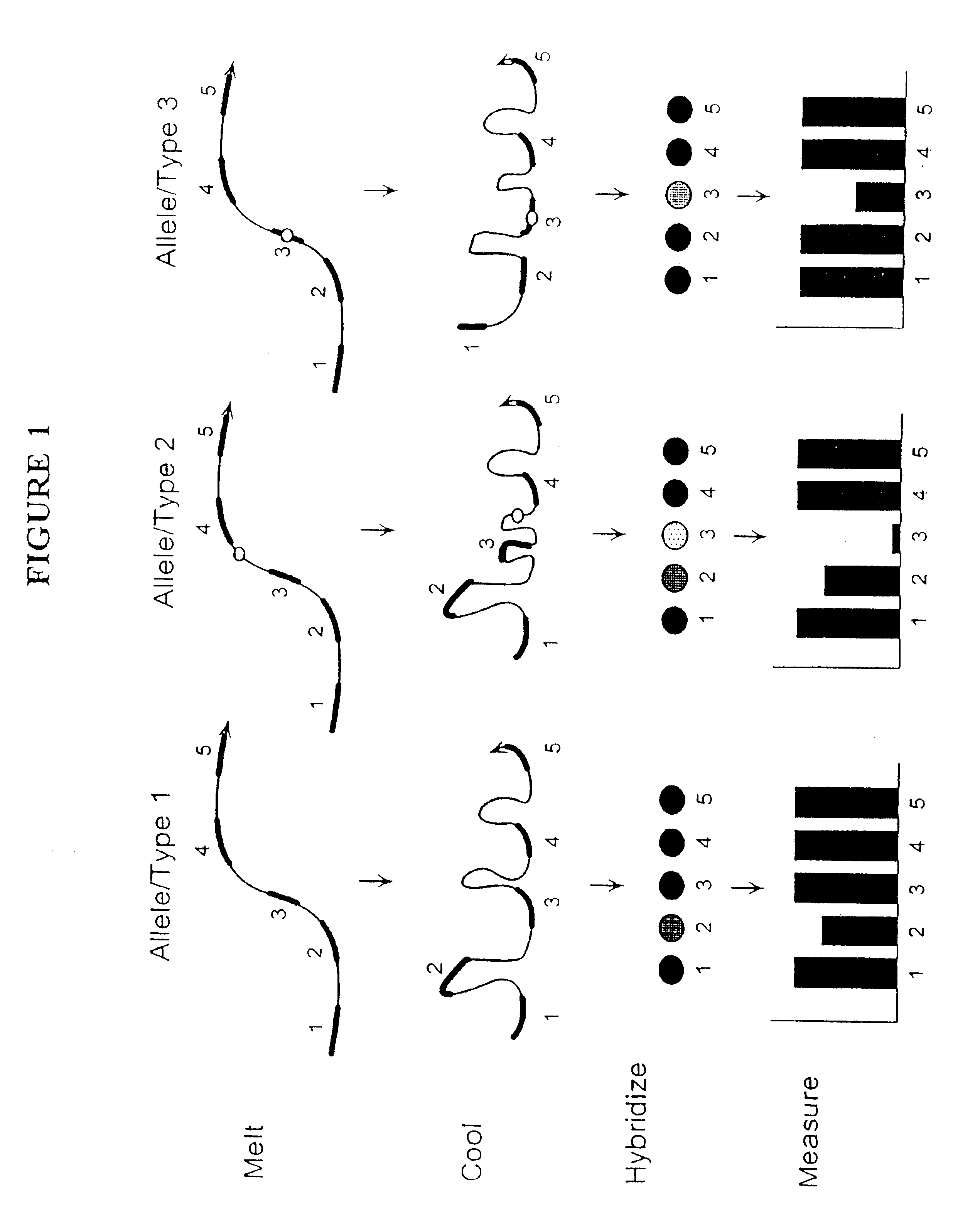Target-dependent reactions using structure-bridging oligonucleotides
a structure-bridging oligonucleotide and target-dependent technology, applied in the field of nucleic acid detection and sequence change detection and characterization, can solve the problems of lack of sensitivity, too labor-intensive and expensive methods to be practical and effective in clinical settings, and lack of background cleavag
- Summary
- Abstract
- Description
- Claims
- Application Information
AI Technical Summary
Problems solved by technology
Method used
Image
Examples
example 1
The Presence of a Structure and a Probe Mismatch in Combination Provide More Sensitive Discrimination Than Does Either Effect Alone
In this Example, the effects on oligonucleotide binding of either the formation of an occlusive structure, the presence of a single-base mismatch, or the presence of both at once were examined. To separate the effects on the efficiency of binding of structure from the effects of mismatches, four katG DNA target variants were chosen (SEQ ID NOS:1, 2, 3 and 4). The structures of these four targets in the region of the probe hybridization sites are shown in FIGS. 2A-2D and the existence of the large stem-loop in structures 2C. and 2D (SEQ ID NOS:3 and 4, respectively) was confirmed by digestion with the structure-specific Cleavase.RTM.I nuclease (Third Wave) and the cleavage sites are indicated by the arrows on structures 2C and 2D. The dark bar on the left of each structure in FIGS. 2A-2D indicates the region to which the capture probe is expected to bind....
example 2
Changes in DNA Secondary Structure Leads to Different Binding Abilities Between the Target DNA and the Capture Probe
The context of a target sequence (i.e., the length and identity of the flanking nucleic acid), can influence the secondary structure, and therefore the hybridization accessibility of the target segment. To illustrate this effect, a target segment of DNA was exposed, either with or without pretreatment with a restriction enzyme, to a capture probe that is complementary to a site that is unaffected by the restriction cleavage. The restriction enzyme BamHI was used to digest the 391 bp 5'-fluorescein labeled fragments of katG DNA, either wild-type (FIG. 2C) or the S315T mutant (FIG. 2B), prepared as described in Example 1. The restriction enzyme shortens the 5' labelled fragment from 391 nt to 256 nt. The capture probe is complementary to sequence located within the first 50 nt of these katG DNA targets. Equal amounts of the DNA targets were used in all the reactions. The...
example 3
Hybridization Analysis Using Multiple Capture Probes for HCV Genotyping
Because both mismatches and structures are used in the method of the present invention for discrimination between similar nucleic acids by hybridization, the patterns created by the use of a structure specific nuclease, e.g., Cleavase.RTM. I nuclease can be used as a way of selecting regions likely to demonstrate different binding behaviors with different variants. Because the CFLP.RTM. method indicates the presence of structure in a DNA fragment of interest, and because the variations in the structures tend to be proximal to the actual sequence changes, choosing capture probes at or near the CFLP.RTM. cleavage sites increases the probability of choosing a sequence that changes in accessibility in the different variants. FIG. 5 shows a diagram depicting this means of probe selection as applied to the comparison of fragments from the Hepatitis C virus. In FIG. 5, the left panel shows an fluoroimager scan of sequen...
PUM
| Property | Measurement | Unit |
|---|---|---|
| Mass | aaaaa | aaaaa |
| Concentration | aaaaa | aaaaa |
| Structure | aaaaa | aaaaa |
Abstract
Description
Claims
Application Information
 Login to View More
Login to View More - R&D
- Intellectual Property
- Life Sciences
- Materials
- Tech Scout
- Unparalleled Data Quality
- Higher Quality Content
- 60% Fewer Hallucinations
Browse by: Latest US Patents, China's latest patents, Technical Efficacy Thesaurus, Application Domain, Technology Topic, Popular Technical Reports.
© 2025 PatSnap. All rights reserved.Legal|Privacy policy|Modern Slavery Act Transparency Statement|Sitemap|About US| Contact US: help@patsnap.com



